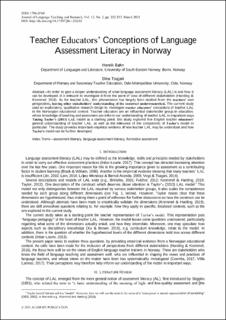Teacher Educators’ Conceptions of Language Assessment Literacy in Norway
Peer reviewed, Journal article
Published version
Permanent lenke
https://hdl.handle.net/11250/2770676Utgivelsesdato
2021-03-01Metadata
Vis full innførselSamlinger
Originalversjon
Journal of Language Teaching and Research (JLTR). 2021, 12 (2), 222-233. http://dx.doi.org/10.17507/jltr.1202.02Sammendrag
In order to gain a deeper understanding of what language assessment literacy (LAL) is and how it can be developed, it is relevant to investigate it from the point of view of different stakeholders (Harding & Kremmel, 2016). As for teacher LAL, this phenomenon has largely been studied from the teachers’ own perspectives, leaving other stakeholders’ understanding of the construct underresearched. The current study used an exploratory, qualitative research design to investigate teacher educators’ conceptions of teacher LAL in the Norwegian educational context. Teacher educators are an influential stakeholder group in education, whose knowledge of teaching and assessment can inform our understanding of teacher LAL in important ways. Taking Taylor’s (2013) LAL model as a starting point, this study explored five English teacher educators’ general understanding of teacher LAL, as well as the relevance of the components of Taylor’s model in particular. The study provides important empirical evidence of how teacher LAL may be understood and how Taylor’s model can be further developed.
